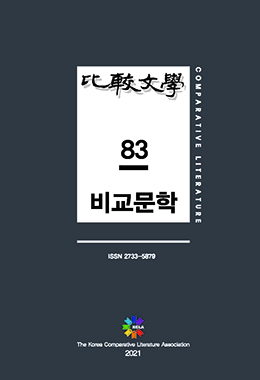본 연구는 2000년대 통일 독일에서 등장한 홀로코스트 증언 다큐멘터리가 독일 사회 담론 속에서 작동하는 방식에 대해 질문한다. 그간 홀로코스트 증언에 대한 영상 기록은 잘 알려진 <쇼아>(Claude Lanzmann, 1985)에서와 같이 피해자 증언을 중심으로 제작된 경향이 있다. 하지만 독일 통일 이후 2000년대에는 홀로코스트 피해자 증언이 아니라 나치와 직접 연루된 사람이나 그들의 가족 얘기를 다룬 다큐멘터리들이 다수 등장한다. 이들 작품은 무엇보다도 자신이 나치범죄에 연루되었다는 오랫동안 숨겨온 사실을 카메라 앞에서 증언 혹은 고백하는 형식을 따른다. 그렇다면 2000년대 독일 사회에서 이러한 다큐멘터리 증언 혹은 고백이 지속적으로 등장해 온 배경은 무엇인가? 또한 이들은 통일 후 독일 사회에서 변화된 홀로코스트 담론을 어떻게 반영하고 동시에 영향을 끼치는가? 그리고 이러한 증언이 카메라 앞에서 수행된다는 점에서 이들 다큐멘터리 증언이 어떻게 독일 사회 내 전후 세대의 목소리를 효과적으로 담아내는가? 본 연구는 이러한 질문에 답하고자 하며, 이를 위해 2000년대 가해자 기억 다큐멘터리의 대표적 사례로서 <히틀러의 비서>(2002)와 <그에 대해 알고 있는 두세 가지 것들>(2005)을 분석한다. 이를 통해 본 연구는 이들 작품 속에 활용된 증언과 고백, 그리고 영상 기록으로서의 사진과 홈비디오 푸티지 등이 나치 폭력의 가해자나 전후 세대로서의 증언자들이 지녔던 죄책감과 수치심을 어떻게 드러내며, 이 과정에서 독일 담론 지형을 어떻게 반영하는지 살펴본다. 또한 본 연구는 증언 다큐멘터리가 지닌 미디어적 특성에 주목함으로써, 이러한 미디어적 특성이 가해자 증언과 고백을 어떻게 기록하는지 논의하고 나아가 영화 속 증언자뿐 아니라 영화 관객으로서의 전후 세대가 과거를 바라보는 방식을 어떻게 변화시키는지 탐구한다.
This essay examines how the Holocaust testimony documentaries, which came out in the 2000s, reflect the changing cultural discourse after the German reunification. Video testimonies and related discourses tended to appear, particularly recording victims’ voices, as in the case of Shoah (Claude Lanzmann, 1985). However, German documentary films in the 2000s frequently depict people involved in the Nazis crimes and the perpetrators’ families, instead of conveying the voices of the Holocaust victims. Significantly, these documentaries adopt the mode of testifying or confessing in front of the camera when these perpetrators seek to reveal the long-kept secret regarding their involvement in Nazi crimes. Then, what is the background in which such documentary testimony or confession has continued to appear in German society during the 2000s? Also, how do they reflect and influence the Holocaust discourses that have changed in German society after the reunification? Considering that these testimonies are carried out in front of the camera, how do these documentary testimonies effectively capture the voices of postwar generations in German society? In an attempt to answer these questions, this study examines two documentary films, Hitler’s Secretary (2002) and 2 or 3 Things I Know About Him (2005) as representative cases that document the perpetrators’ memories in the 2000s. Through this, I seek to understand how testimonies and confession appeared in these documentaries disclose the guilt and shame that the perpetrators of Nazi violence and their children had to carry; and in so doing, how these films reflect (and influence) the changing geography of the German discourse on the Holocaust. My exploration will also highlight how the media aspects embedded in these documentary testimonies help change the way the postwar generations as movie viewers as well as witnesses in the film see the past.




